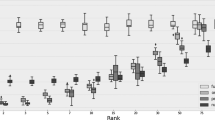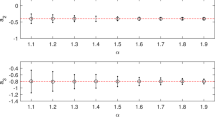Abstract
In this paper, we present a new approach for modelling matrix-variate time series data that accounts for smooth changes in the dynamics of matrices. Although stylized facts in several fields suggest the existence of smooth nonlinearities, the existing matrix-variate models do not account for regime switches that are not abrupt. To address this gap, we introduce the matrix smooth transition autoregressive model, a flexible regime-switching model capable of capturing abrupt, smooth and no regime changes in matrix-valued data. We provide a thorough examination of the estimation process and evaluate the finite-sample performance of the matrix-variate smooth transition autoregressive model estimators with simulated data. Finally, the model is applied to real-world data.













Similar content being viewed by others
References
Ahmed, M. Y., & Sarkodie, S. A. (2021). COVID-19 pandemic and economic policy uncertainty regimes affect commodity market volatility. Resources Policy, 74, 102303.
Anderson, H. M., & Vahid, F. (1998). Testing multiple equation systems for common nonlinear components. Journal of Econometrics, 84, 1–36.
Angelini, G., Bacchiocchi, E., Caggiano, G., & Fanelli, L. (2019). Uncertainty across volatility regimes. Journal of Applied Econometrics, 34(3), 437–455. https://doi.org/10.1002/jae.2672
Baker, S. R., Bloom, N., & Davis, S. J. (2016). Measuring economic policy uncertainty. The Quarterly Journal of Economics, 131(4), 1593–1636.
Billio, M., Casarin, R., Costola, M., & Iacopini, M. (2022). Matrix-variate smooth transition models for temporal networks. In A. Bekker, J. T. Ferreira, M. Arashi, & D.-G. Chen (Eds.), Innovations in multivariate statistical modeling: Navigating theoretical and multidisciplinary domains (pp. 137–167). Cham: Springer.
Billio, M., Casarin, R., Iacopini, M., & Kaufmann, S. (2022). Bayesian dynamic tensor regression. Journal of Business and Economic Statistics. https://doi.org/10.1080/07350015.2022.2032721
Brockwell, P., & Davis, R. (1991). Time series: Theory and methods. Spring.
Chen, R., Xiao, H., & Yang, D. (2021). Autoregressive models for matrix-valued time series. Journal of Econometrics, 222(1, Part B), 539–560.
Guptar, A., & Nagar, D. (1999). Matrix variate distributions. Chapman and Hall/CRC.
Hamilton, J. D. (1994). Time series analysis. Princeton University Press.
He, C., Teräsvirta, T., & González, A. (2008). Testing parameter constancy in stationary vector autoregressive models against continuous change. Econometric Reviews, 28(1–3), 225–245. https://doi.org/10.1080/07474930802388041
Hillebrand, E., Medeiros, M. C., & Xu, J. (2013). Asymptotic theory for regressions with smoothly changing parameters. Journal of Time Series Econometrics, 5(2), 133–162. https://doi.org/10.1515/jtse-2012-0024
Horn, R. A., & Johnson, C. R. (1985). Matrix analysis. Cambridge: Cambridge University Press. https://doi.org/10.1017/CBO9780511810817
Hubrich, K., & Teräsvirta, T. (2013). Thresholds and smooth transitions in vector autoregressive models. In (Vol. 32). https://doi.org/10.1108/S0731-9053(2013)0000031008
Janus, J. (2021). The COVID-19 shock and longterm interest rates in emerging market economies. Finance Research Letters, 43, 101976.
Kandić, M., & Peperko, A. (2016). On the submultiplicativity and subadditivity of the spectral and essential spectral radius. Banach Journal of Mathematical Analysis, 10(1), 133–146. https://doi.org/10.1215/17358787-3345005
Leng, C., & Tang, C. Y. (2012). Sparse matrix graphical models. Journal of the American Statistical Association, 107(499), 1187–1200. https://doi.org/10.1080/01621459.2012.706133
Liu, J. (1992). Spectral radius, Kronecker products and stationarity. Journal of Time Series Analysis, 13(4), 319–325. https://doi.org/10.1111/j.1467-9892.1992.tb00110.x
Liu, X., & Chen, R. (2020). Threshold factor models for high-dimensional time series. Journal of Econometrics, 216(1), 53–70.
Liu, X., & Chen, E. Y. (2022). Identification and estimation of threshold matrix-variate factor models. Scandinavian Journal of Statistics, 49(3), 1383–1417. https://doi.org/10.1111/sjos.12576
Lundbergh, S., Teräsvirta, T., & van Dijk, D. (2003). Time-varying smooth transition autoregressive models. Journal of Business and Economic Statistics, 21(1), 104–121.
Quandt, R. E. (1958). The estimation of the parameters of a linear regression system obeying two separate regimes. Journal of the American Statistical Association, 53(284), 873–880.
Samadi, S. Y. (2014). Matrix time series analysis (Ph.D. Thesis).
Schleer, F. (2015). Finding starting-values for the estimation of vector star models. Econometrics, 3(1), 65–90.
Teräsvirta, T., & Yang, Y. (2014). Specification, estimation and evaluation of vector smooth transition autoregressive models with applications (Tech. Rep.). Department of Economics and Business Economics, Aarhus University. (CREATES Research Paper, Aarhus University).
Tsay, R. S. (1998). Testing and modeling multivariate threshold models. Journal of the American Statistical Association, 93(443), 1188–1202.
Tsay, R. S. (2014). Multivariate time series analysis: With R and financial applications. Wiley Series in Probability and Statistics.
Wang, D., Liu, X., & Chen, R. (2019). Factor models for matrix-valued high-dimensional time series. Journal of Econometrics, 208(1), 231–248.
Zhang, H.-F. (2023). Additive autoregressive models for matrix valued time series. Journal of Time Series Analysis. https://doi.org/10.1111/jtsa.12718
Zhou, S. (2014). Gemini: Graph estimation with matrix variate normal instances. The Annals of Statistics, 42(2), 532–562.
Zhou, H., Li, L., & Zhu, H. (2013). Tensor regression with applications in neuroimaging data analysis. Journal of the American Statistical Association, 108(502), 540–552. https://doi.org/10.1080/01621459.2013.776499
Funding
The authors have not disclosed any funding.
Author information
Authors and Affiliations
Corresponding author
Ethics declarations
Conflict of interest
The author declares that he has no conflicts of interest.
Additional information
Publisher's Note
Springer Nature remains neutral with regard to jurisdictional claims in published maps and institutional affiliations.
Rights and permissions
Springer Nature or its licensor (e.g. a society or other partner) holds exclusive rights to this article under a publishing agreement with the author(s) or other rightsholder(s); author self-archiving of the accepted manuscript version of this article is solely governed by the terms of such publishing agreement and applicable law.
About this article
Cite this article
Bucci, A. A Smooth Transition Autoregressive Model for Matrix-Variate Time Series. Comput Econ (2024). https://doi.org/10.1007/s10614-024-10568-7
Accepted:
Published:
DOI: https://doi.org/10.1007/s10614-024-10568-7




